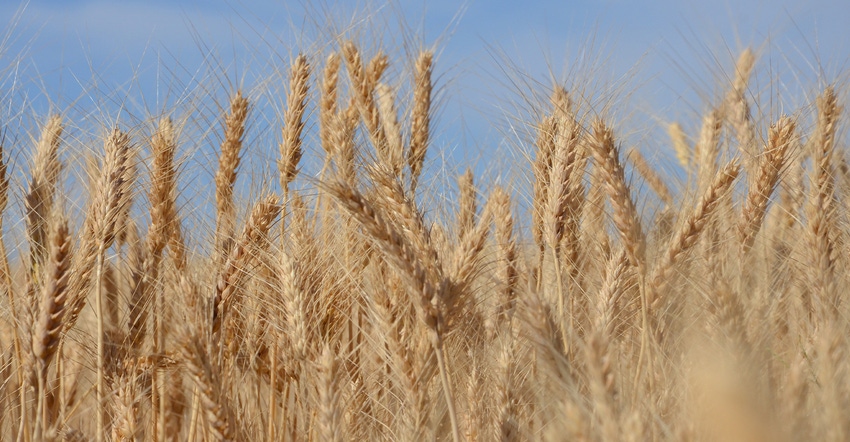August 28, 2019

Hybrid crops offer the potential for improved yield, disease resistance and yield stability over inbred varieties. Plant breeders began to develop hybrid corn in the 1920s, and the first hybrids started showing up soon after. One crop that offers similar higher yield and performance potential is wheat — but where is the hybridization research for that crop?
The first hybrid varieties of wheat were tested in the 1970s, and today’s plant breeders expect to release hybrid wheat to the general market in the mid-2020s. Yet, hybrid wheat presents more challenges than corn, because it self-pollinates.
“Wheat doesn’t have a tassel,” Ed Souza, BASF Corp. global head for wheat breeding, points out. “My life would be a lot easier if it just had a tassel I could pull off. Today’s advanced genetic tools enable us to breed hybrid wheat, and at a cost-effective point that wasn’t possible before.”
Hybrid expectations
The BASF breeding program sees greater and earlier vigor in hybrid plants, which allows it to grow with lower seeding rates. The increased grain yield also means growers will need to fertilize to a target yield to achieve the desired grain protein.
“We see in our trials that hybrids generally have very good nitrogen use efficiency,” Souza says. “We develop guidelines so that farmers can realize those opportunities of plant vigor, greater yield and greater efficiency.”
Souza feels that BASF hybrid wheat holds the best-in-class resistance to fusarium head blight, particularly in the spring wheat species. “We emphasize development of good, stable rust resistance; and resistances to common Great Plains viruses, such as wheat streak mosaic.” he explains,
BASF and AgriPro Syngenta both operate hybrid wheat breeding programs. Jon Rich, AgriPro Syngenta wheat breeder, says that hybrid wheat will provide more return on investment for farmers over multiple years.
“Hybrid wheat buffers the environmental impacts that change year to year, whether it’s drought, heat or disease,” Rich says. “Especially with winter wheat, when you plant in the fall and harvest the next spring or summer. We don't know all of the things that the plant will go through during those times. Hybrid wheat is more resilient and can help manage farmers’ risks to bring more revenue to their farm.”
Genetic factors
Through 50 years of wheat research, plant breeders learned how to maneuver a self-pollinated crop into a cross-pollinated crop. Now they study which plant parents — with desired traits of disease resistance, yield and vigor — make the best crosses, set the best seed and production, and bring the highest yields.
“At this stage of hybrid wheat, [BASF] has two challenges to scale up for our launch,” Souza says. “We need to validate yield improvement of the hybrids over conventional inbred varieties. This requires us to test, and test again, across many different management systems. Also, we use new technology to create the hybrids. We continue to test these to validate the high level of performance.”
These tests include studies of seeding rates, crop protection and fertilizer. Souza’s team finds that the higher yields and increased vigor of the hybrid require specific field management. BASF’s research will map best practices for use by a wide variety of farming operations.
Similarly, Rich says that AgriPro’s hybrid wheat test plots show yield increases of 10% to 15%. But to achieve that, growers must increase their management by 3% to 5% percent. “With our test growers, we implement fertility, seed treatments and fungicides, because the yield advantage comes from learning how to use agronomics better to grow the hybrids.” he says.
Store or buy?
Some wheat farmers prefer to save and “bin-run” seed for their next crop. Hybrid wheat will not perform well under such management. “The saved [hybrid wheat] seed would be less uniform, [have] less yield and have problems with maturity,” Souza explains. “But the opportunities [of hybrid wheat] offset the cost of buying seed every year.”
Plant breeders produce hybrid seed from two pure strains that breed true. Farmers will purchase first-generation, uniform hybrid seed from these parents. “After that generation, the genes segregate,” Souza says. “Saved seed from a uniform crop will produce plants that are tall and short, early- and late-maturing, and with various disease and quality characteristics. We can capture all the preferred genetics for one generation and do it more efficiently than in a line program, but then the next generation loses the efficient combination.”
Prepare for hybrids
Market launch of hybrid wheat remains five years in the future — but Rich recommends farmers begin to prepare now. “For success with hybrid wheat, you should learn how the current genetics from the varietal side react on your ground,” he advises. “You need to understand how to manage fertility programs, seed treatments and fungicides in different environmental situations. We want to bring this new technology to the marketplace because we think cereals needs a big yield bump to make it a more profitable crop.”
Hemken writes from Lander, Wyo.
About the Author(s)
You May Also Like




